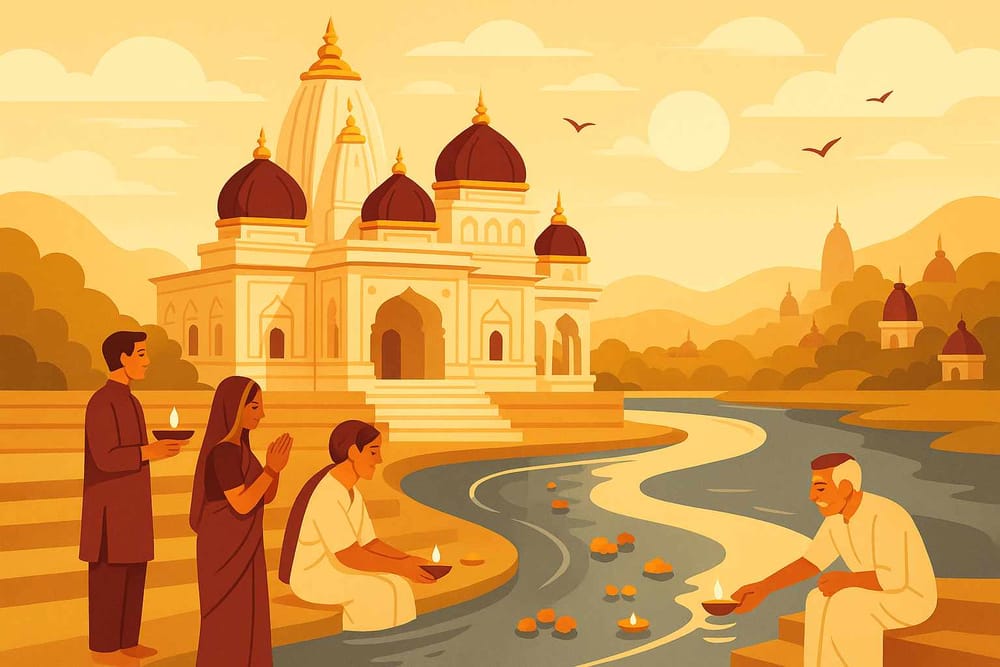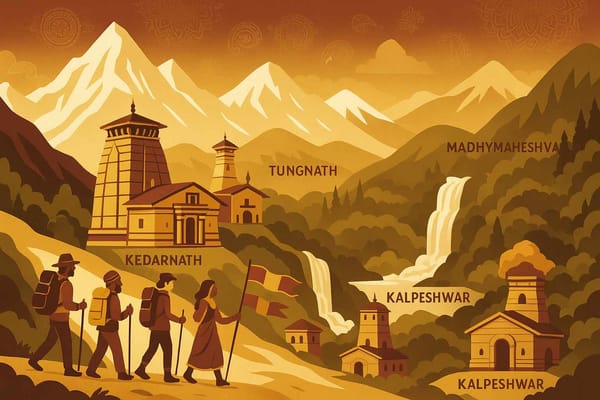
India's Sacred Geography: Temples, Tirthas & Cultural Impact - A 2025 Exploration
India's temples and sacred sites aren't just places of worship; they are living embodiments of the country's rich spiritual heritage and cultural history. These holy places showcase incredible architecture, house timeless traditions, and serve as vital centers of community life. Let's explore their unique designs, the roles they play beyond worship, and the traditions that make them so special in modern India.
Exploring India's Sacred Architecture and Cultural Heritage
Indian temple architecture varies significantly across regions, reflecting the diversity of local culture, available resources, and spiritual philosophies.
- North Indian Temples (Nagara Style): These temples are instantly recognizable by their tall, sharply rising spires called shikharas, symbolizing the connection between earth and the heavens. Intricate carvings adorn the temple walls, depicting deities, mythical stories, and celestial beings, adding to the spiritual aura. Famous examples include the Khajuraho Temples and the majestic Sun Temple in Konark, Odisha.
- South Indian Temples (Dravidian Style): Known for their sprawling complexes, these temples boast monumental entrance towers known as gopurams, covered in incredibly detailed sculptures. These gopurams often dwarf the main shrine, creating a sense of awe and wonder. Iconic examples include the Meenakshi Amman Temple in Madurai and the Brihadeeswara Temple in Thanjavur, Tamil Nadu.
Beyond the regional styles, some common threads weave through India's temple architecture:
- Materials and Construction: North Indian temples frequently use sandstone, while South Indian temples predominantly utilize granite due to its abundance in the region. This choice of material reflects the practical considerations of local resources.
- Ritual Purity: Many South Indian temples incorporate temple tanks, known as pushkarinis, for ritual cleansing, a feature less common in North Indian temples. These tanks add to the sanctity of the temple complex.
- Symbolism: Temple layouts often align with cosmic principles and mandala patterns, symbolizing the harmony between humans and the universe. This intricate symbolism adds depth and meaning to the architectural design.
These architectural wonders are more than just physical structures; they are gateways to divine connection and powerful symbols of cultural preservation.
Beyond Worship: Temples as Centers of Community Life
Indian temples are vibrant community hubs that play a crucial role in various aspects of daily life, extending far beyond their religious function.
- Festivals and Gatherings: Temples serve as the backdrop for grand celebrations and festivals, such as the Rath Yatra in Puri and Navaratri in Gujarat, bringing people together in shared joy and devotion. These events strengthen community bonds and pass down cultural traditions through generations.
- Economic Impact: Temple towns like Tirupati, Andhra Pradesh, generate significant economic activity. They provide livelihoods for a diverse range of people, including priests, artisans, cooks, flower vendors, and shopkeepers. This economic activity ripples through the community, supporting local businesses and families.
- Education Centers: Many temples have historically served as centers of learning, maintaining schools that teach Sanskrit, ancient scriptures, and traditional arts. This role in education helps preserve India's rich intellectual and cultural heritage. Examples include traditional pathshalas and Vedic schools attached to temples.
- Cultural Contributions: Classical dance forms like Bharatanatyam and Odissi have their roots in temple rituals and traditions. These art forms, nurtured within the temple walls, continue to enrich India's cultural landscape and inspire artists worldwide.
- Philanthropy: Through anna daana (food donation), temples ensure that no one goes hungry, embodying the spirit of compassion and community care. This tradition of providing free meals is a lifeline for many, especially the underprivileged.
- Craft Preservation: Temples support traditional crafts and artisans. The intricate carvings, sculptures, and temple decorations provide employment for skilled craftspeople, helping keep these ancient art forms alive.
Temple Cuisine: The Sacred Offering of Prasadam
Prasadam, the food offered to the deity and then shared with devotees, is more than just a meal; it's a sacred offering, imbued with spiritual significance.
- Regional Varieties: Prasadam varies across regions, reflecting the diversity of India's culinary landscape. From the sweet pongal of Tamil Nadu to the tangy puliyodarai of Andhra Pradesh and the iconic Mahaprasad of Puri, each offering carries a unique flavor and cultural significance. This variety showcases the rich tapestry of culinary traditions across India.
- Spiritual Symbolism: The act of sharing prasadam transcends social barriers, promoting equality and unity among devotees. It's a reminder that in the eyes of the divine, everyone is equal.
- Grand Kitchens: Some temples, like the Tirupati temple, have massive kitchens that operate with remarkable efficiency, feeding thousands of devotees daily. These kitchens are a fascinating blend of ancient tradition and modern logistics.
- Eco-Friendly Practices: Many temples adhere to eco-friendly practices by using biodegradable plates made of banana leaves or clay pots, minimizing waste while maintaining purity standards. This reflects a growing awareness of environmental responsibility within temple traditions.
Embrace India's Sacred Geography with Bhaktilipi
Bhaktilipi.in brings you closer to the heart of devotion through sacred texts, timeless stories, and inspiring hymns. We offer carefully curated devotional literature in both original languages and translations, making them accessible to everyone. Our platform is designed for modern readers who value tradition but appreciate convenience and clarity.
Explore India's rich spiritual heritage—temples, holy sites, and their cultural impact—with us. Discover how these traditions can enrich your life. Subscribe to our newsletter for updates on new content and features.
Follow us on Facebook, Instagram, and YouTube for more insights. Let's preserve, reimagine, and share the wisdom of bhakti together!
India's Sacred Geography in 2025 and Beyond
India's sacred geography is a reflection of its soul. Temples and tirthas serve as bridges between the mortal and the divine, the individual and the community, and the past and the future. These spaces are not just places of worship; they are repositories of tradition, centers of artistic brilliance, and symbols of cultural unity.
As we explore these marvels in 2025 and beyond, let's honor their timeless essence while appreciating their evolving role in modern society. Whether you seek spiritual solace, historical understanding, or cultural immersion, these temples offer a profound connection to something larger than oneself.
By celebrating India's sacred geography, we celebrate the enduring values of devotion, generosity, and unity that these temples inspire. They are not merely landmarks but living legacies of a rich and diverse heritage.
Embark on a Journey into Devotion and Timeless Wisdom with Bhaktilipi
A passionate group of people dedicated to preserving India's knowledge of Dharma, Karma, and Bhakti for ourselves and the world 🙏.
Comments
Related in

India's Sacred Geography: A Panch Kedar Pilgrimage Guide
Embarking on the Panch Kedar Yatra is a deeply spiritual journey into the Garhwal Himalayas of Uttarakhand. This sacred circuit of five temples—Kedarnath, Tungnath, Rudranath, Madhyamaheshwar, and Kalpeshwar—honors Lord Shiva in his various forms. Rooted in mythology, this pilgrimage offers an enriching blend of devotion, breathtaking landscapes, and

India's Sacred Geography: Your 2025 Poojn Guide to Spiritual Exploration
India, a land where spirituality intertwines with everyday life, is dotted with sacred sites that whisper tales of ancient wisdom and divine energy. These holy places, from grand temples to serene natural wonders, offer a pathway to connect with the divine. And with today's digital age, planning a
